Say no to Shafston House Development- 1988 – current (2022)
In 1988 the Government leased the one hectare riverside Shafston Estate for two consecutive 99-year leases to entrepreneur Gary Balkin, (1940 – 2018 ) owner of the Kookaburra Queen Paddle Steamers and founding father of the Broncos.
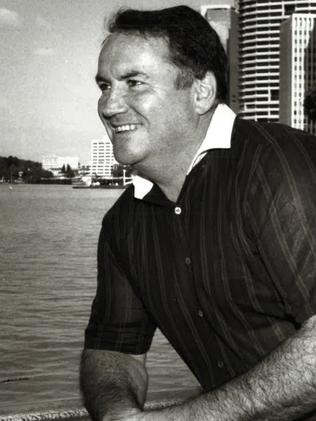
When his application for a restaurant and function venue was declined by the City Council, the house was again refurbished as a residence.
In 1993 Balkin sold the lease to prominent Queensland developer, shipbuilder and businessman Keith Lloyd for $1.8 million. Lloyd founded the very successful Shafston International College which opened in 1996 and catered mainly for international students.

The main house was refurbished and filled with beautiful antique furnishings and art works. Major works were carried out to the grounds and other buildings. The link to the kitchen wing was enclosed with a new sitting room; The open air ward was enclosed and a concrete board walk and new retaining wall were installed on the river frontage in accordance with local Council requirements. The property was converted to freehold title some time between 1998 and 2002.

In 2004 the college was embroiled in a widely-reported scandal when several students made allegations of sexual misconduct against the college president, Keith Lloyd. He was immediately sacked by the Board and denied access to the premises. However, after a police investigation no charges were laid. The College continued operating but eventually closed in November 2020.

The entire Shafston House estate which had been on the Register of the National Estate since 1978 was added to the Queensland Heritage Register on 7 February 2005 for its historical, cultural and aesthetic significance.

On 1 February 2021 Keith Lloyd sold the property to Kevin Pan, director of Burgundy Group Property Development Pty Ltd for about $20 million, the land alone was valued at $17.8 million.
In January 2022 the Burgundy Group company lodged a Development Application which includes a 15-storey apartment block to be built next to the historic Shafston House, two river homes on the lower part of the lawn, turning Shafston House into multiple apartments, converting the ward buildings into residential units and reducing the overall ground planting. As the application is code assessable it is not subject to public notification or appeal, but Brisbane City Council welcomed comments.
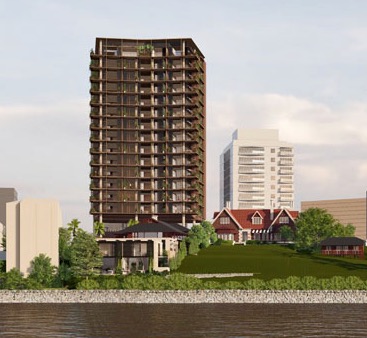
The proposed development has met with fierce opposition from local residents and history lovers all over Brisbane and Queensland. The proposed 15-storey tower would dwarf the beautiful historic house and dominate the site. The river units would further block the views to the house from the river. Hundreds of submissions have been made to BCC protesting against the development plans for this iconic and magnificent heritage estate.
As the property is State heritage-listed all development plans have to be submitted to the State Assessment and Referral Agency (SARA). SARA’s initial advice to the developer was that” your development application has not adequately demonstrated compliance with the State Development Assessment Provisions (SDAP). “
SARA rejected key elements of the proposal:
- the 15 storey tower is unacceptable “Given its proximity to the main residence of Shafston House, the bulk, scale and visual appearance of the proposed 15-storey tower will have a substantial detrimental impact on the landmark status of the Queensland heritage place.”
- the riverside homes cannot go ahead as they would restrict the iconic views of Shafston House to and from the river,
- the main house cannot be converted into apartments but must remain ‘a single unit dwelling’
- the former orderlies building cannot be turned into residential units
SARA has agreed twice to extend the ‘referral agency assessment period’, so the developer currently has until 18 July 2022 to respond to the issues raised by SARA.
Kindergarten Training College 1915-1919
Shafston House played a major role in the history and development of Early Childhood Education in Queensland.
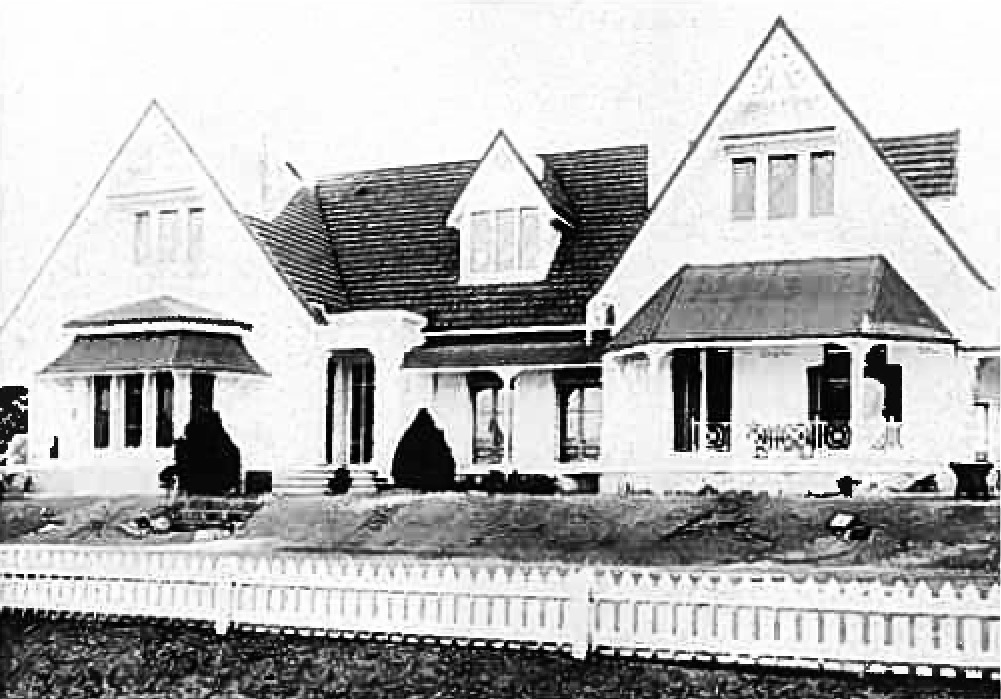
From 1904 to about 1913 Shafston was the town home of the prominent pioneering McConnel family. After the family’s move to their country property Cressbrook in the Esk district, Elizabeth McConnel leased the property to the Creche and Kindergarten Association (C & K) for use as a Kindergarten Training College.
The C & K had been formed in 1907 to provide free creches and early childhood education for the children of poor working mothers. The first creche and kindergarten facility was opened in 1907 in a former tobacco factory in Fortitude Valley. It was run by Caroline Liggins and staffed by pupil-teachers.
In 1911, the C & K established the Brisbane Kindergarten Training College to cater for the growing need of pupil-teachers for more than just practical experience. Caroline Liggins was the first Principal and lecturer. Pupil-teachers worked in a nursery or kindergarten in the morning and attended classes in methodology and theory in the afternoon. The first course started with five students who paid six guineas per year for the two-year course. Classes were held in several temporary locations in the city including Rothwells buildings in Edward Street and the School of Arts.
Formation of the Kindergarten Training College marked the beginning of more formal teacher training in Queensland which up to then had relied on the informal system of pupil-teachers. The Queensland Teacher Training College would be established three years later in 1914.
Interest in kindergarten teaching as a career for girls grew rapidly, leading to increased student numbers in 1914 and putting pressure on the city accommodation. When applications started to come in from country students the need for a residential college became evident and the search for suitable premises began.
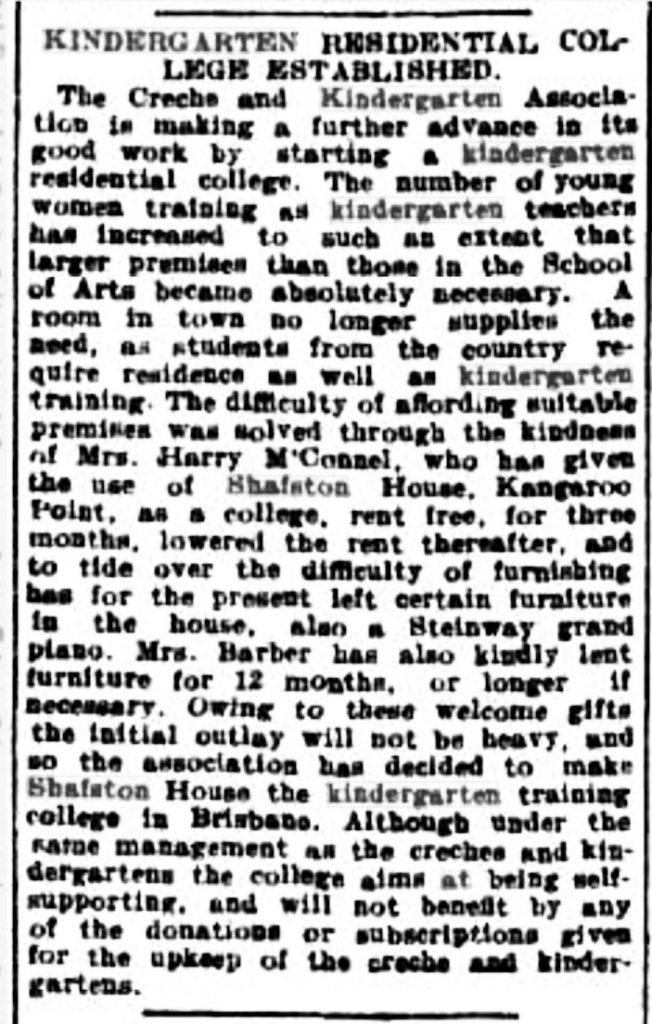
The problem was solved when in early 1915 the C& K accepted the generous offer made by Elizabeth McConnel to lease her property, Shafston House rent-free for three months and then for a nominal annual rental of £2 including use of the furniture and the grand piano.
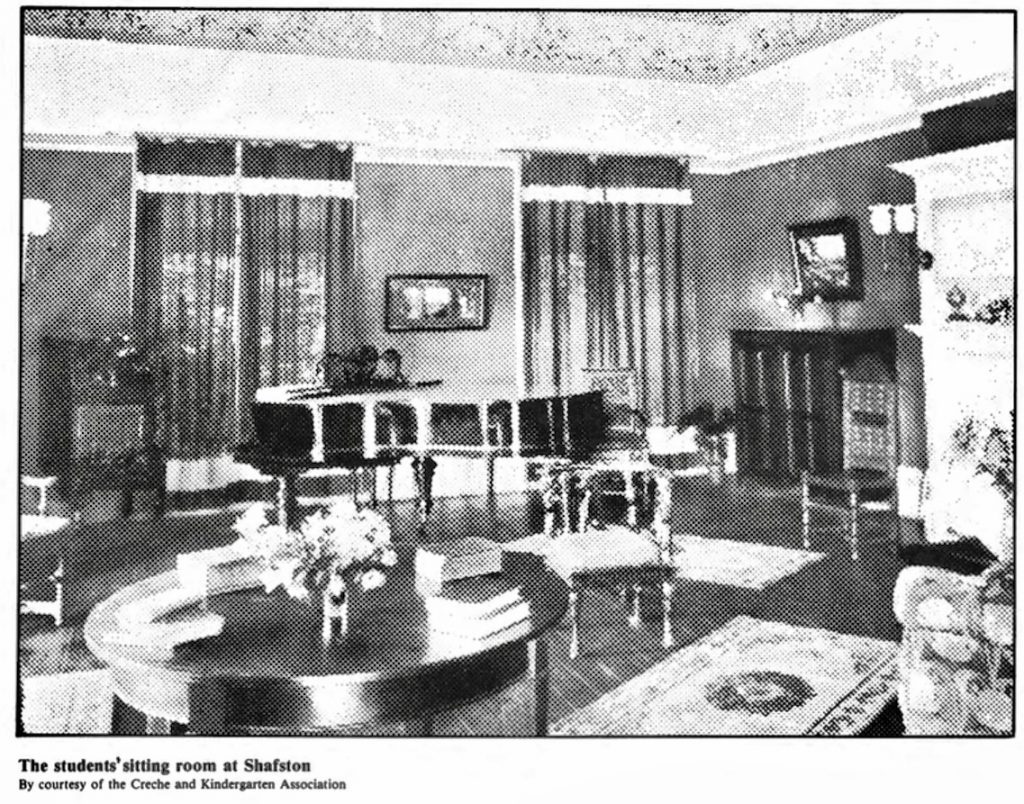 The beautiful and spacious grounds of the Shafston Estate would be an ideal permanent base for lectures and a residence for the principal and country students.
The beautiful and spacious grounds of the Shafston Estate would be an ideal permanent base for lectures and a residence for the principal and country students.

The Kindergarten Training College at Shafston was opened on Tuesday, 7 March 1915 at 3 pm by the Governor, Sir Arthur Morgan, President of the C & K. Students had to be at least 17 years old and paid an annual fee of ten guineas. Some bursaries were available for students whose families could not afford the fees. Student and staff rooms were airy, spacious and beautifully furnished creating an atmosphere conducive to positive learning experiences and social interactions. The move to Shafston marked the beginning of a more formalised phase of the College. The extensive grounds and picturesque location were ideally suited for both the educational needs of the College and its fundraising activities, such as Garden Fetes and outdoor performances.
The move to Shafston marked the beginning of a more formalised phase of the College. The extensive grounds and picturesque location were ideally suited for both the educational needs of the College and its fundraising activities, such as Garden Fetes and outdoor performances.
Trainees conducted kindergarten programmes on the premises for children from the free kindergartens which both staff and students greatly enjoyed. Female university students also boarded there when space was available.
A student Alumnae Association was formed in 1917 and organised fundraising and social activities such as evening entertainment, picnics and class days.
Unfortunately the happy kindergarten training days at Shafston lasted only four years. The property was advertised for sale in 1919 but the C & K could not afford to buy it. it was with deep regret that the College had to look for new premises. The estate was bought by the Government and turned into a Repatriation Hostel (renamed Anzac Hostel) for soldiers permanently disabled in World War I.
RAAF Life at Shafston 1969-1987
Listing of the Register of the National Estate 1978
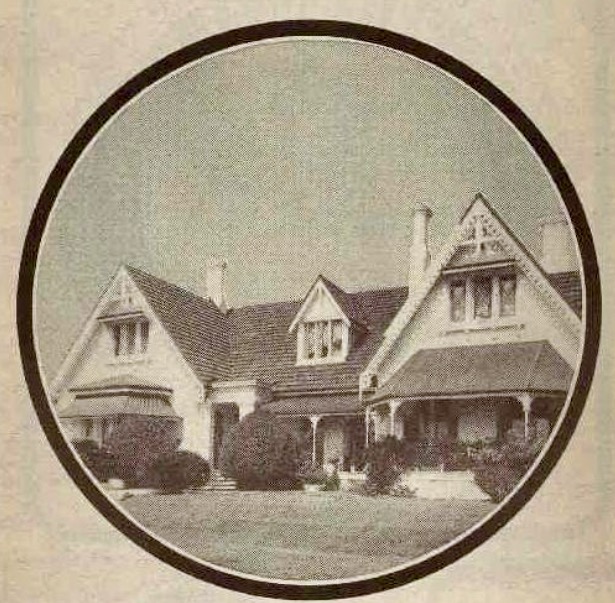


Eighteen years after the RAAF moved into the premises the Government sold the lease to the Shafston House Estate to a private businessman, forcing the RAAF to look for another location.
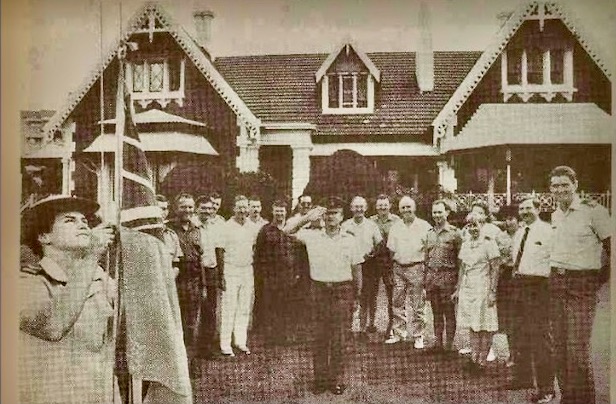
On 15 March 1987 there was a final salute, the flag was lowered and the RAAF days at Shafston came to an end.
The black armbands worn by some unit members were a symbolic indication of how they felt about losing their much-loved historic home, ‘ a National Trust property resplendent in grassy, tree-shaded grounds on the banks of the Brisbane River’. (RAAF News)
RAAF Support Unit 1969-1987

After fifty years serving as the Anzac Hostel (1919-19690) Shafston House was leased to the RAAF for use as a support unit. Once again interior alterations had to be made to make the property suitable for its new use. Changes included upgrading bathrooms facilities, installation of a bar and fire escape, enclosing the verandahs and the previously open sub-floor in the main house. A garage and store were built between the ward block and the river. Alterations to the grounds included new paving, new fencing along the street frontages, new street entrances and driveways, parking areas and tree planting along Castlebar Street and the southern boundaries.
By 1981 the buildings had taken on new functions : the main house was used as the administrative headquarters and mess and for offices for the RAAF Police; the ward block became a ‘Movement Control Centre ‘; the former kitchen block became the headquarters of the Queensland Air Training Corps; the garage/former postal depot housed the RAAF Public Relations and Photographic Section and the former orderlies building became a tavern!
(Queensland State Heritage Register/RAAF archives via Trove)
The Shafston House Estate should always be remembered for the significant contribution it made to the establishment and growth of early childhood education in Queensland.
( Meeting the needs of our children : a history of Brisbane Kindergarten Teachers College, 1911-1981 / Carmel M.T. Byrne. / Trove articles)
The early years 1851 – 1919 Shafston as a Private Residence
The story of Shafston House, Brisbane’s third oldest residence, begins at a land sale on 1 November 1851 when the Reverend Robert Creyke, a pioneer of the Church of England, bought allotments 44 and 45 totalling 10.75 acres (4.2 ha) of the newly surveyed riverfront estate at Kangaroo Point. On lot 44 he built a single-storey brick and stone residence with verandahs and a high-pitched roof overlooking the Brisbane River. He called the house Ravenscott.
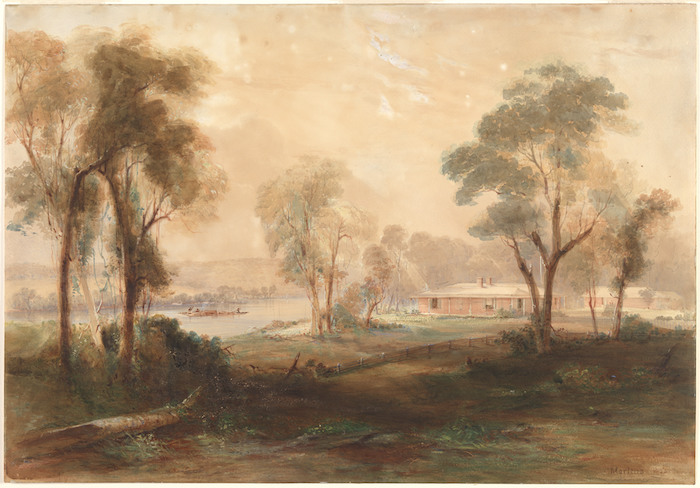
A year later, on 5 December 1852 Henry Stuart Russell, a Darling Downs pastoralist and politician, bought the property and completed the brick and stone house in the Gothic style. He re-named it Shafston after his wife’s birthplace in Jamaica. He also bought several neighbouring blocks to create a town riverine estate of over 44 acres (17.6 hectares).
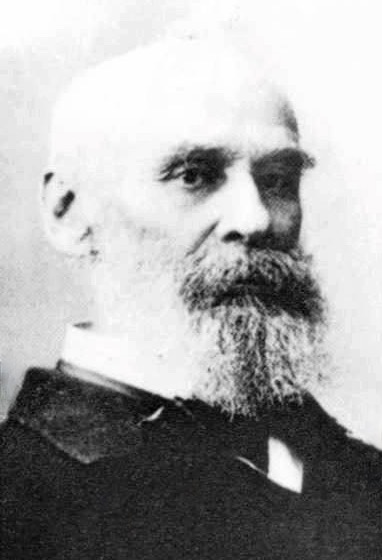
After improvements made by Russell the house had five large bedrooms, a drawing room, dining room and long internal passage with a 160 ft long verandah at the front. Under the drawing room was a stone dairy, larder and an 8 foot- high wine cellar. At the back a covered way connected a brick service block which housed a large kitchen, two servants’ bedrooms, store rooms, offices and a large laundry with a fenced in drying yard. Another brick outbuilding contained two-stall stables a coach house, harness room and two grooms’ rooms with a loft over all. There was also a fowl house, a well and a three-acre garden enclosed by a paling fence. The whole property was enclosed with a four-rail hardwood fence. When his attempts in 1854 and again in 1855 to sell the house were unsuccessful he moved out and ran it as a boarding house.

The next owner was Kilcoy grazier Captain Louis Hope who owned it from September 1859 until 1883 and over the years rented it to several prominent public figures including Daniel Foley Roberts, solicitor; Gilbert Elliot, the first Speaker of the Queensland Parliament 1860-1871; William Barker, grazier and Dr and Mrs Henry Challinor, medical superintendent on the Fortitude (1870s). In 1875 Hope subdivided the property and by 1882 Shafston Estate was reduced to about 4 acres.

Major changes occurred after July 1883 when the now much smaller property was sold to Mary Jane Foster, wife of Charles Milne Foster of a firm of ironmongers, who lived there until 1896. The original house was demolished and a second and much grander house, also called Shafston, was built on the original foundations to a design by prominent colonial architect FDG Stanley. Major design changes were the addition of an entrance portico , more picturesque Gothic detailing and bay windows.
Shafston was tenanted from 1896 until 1904 when it was sold to James Henry McConnel of Cressbrook Station, who transferred it to his wife Elizabeth one minute after receiving ownership and they lived in it for some time. James , the eldest son of David and Mary McConnel, was born in 1850 in the newly-built Toogoolawah (now Bulimba House), the second-oldest riverine estate in Brisbane built 1849-1850.

He commissioned notable architect R S Dods to complete a third renovation of the house. His design features included two imposing fireplaces and elaborate timber work in the front hall and the two main public rooms , the drawing and dining rooms; the first floor dormer windows and all diagonally glazed window panes to first floor.
An overview of the history of Shafston House
Why Shafston House and its site are so important and should be preserved.

The story of Shafston House, the red brick Victorian Gothic style mansion on top of a hill with manicured lawns sloping down to the Brisbane River is an important part of the story of the colonial days and early development of Brisbane and Queensland. It is believed to be the third-oldest house in Brisbane and one of only two of the original southside riverine estate residences which still keep their direct connection to the river [the other is Newstead House 1846].
It is the story of enterprising pioneers, notable architects and influential tenants (1850-1913). It tells of the beginnings of early childhood education (1913-1919); the transition from private use to Government acquisition as a repatriation hospital (Anzac Hostel, 1919-1969), and its roles as Royal Australian Air Force (RAAF) headquarters (1969-1987). It describes the return to private ownership (1993), provision of student education facilities (1996-2020), and the current challenges (2021-2022) of balancing the tension between maintaining the historic ‘status quo’ and the expectations of modern entrepreneurs for development of the site.
The story also highlights the recognition of the cultural significance of Shafston House and grounds when it was entered on the Commonwealth Register of the National Estate in 1978, and on the Queensland Heritage Register in 2005.
Despite having had many owners and tenants and being used for a variety of purposes, the house and grounds have always been well looked after and in accordance with the heritage listing requirements.
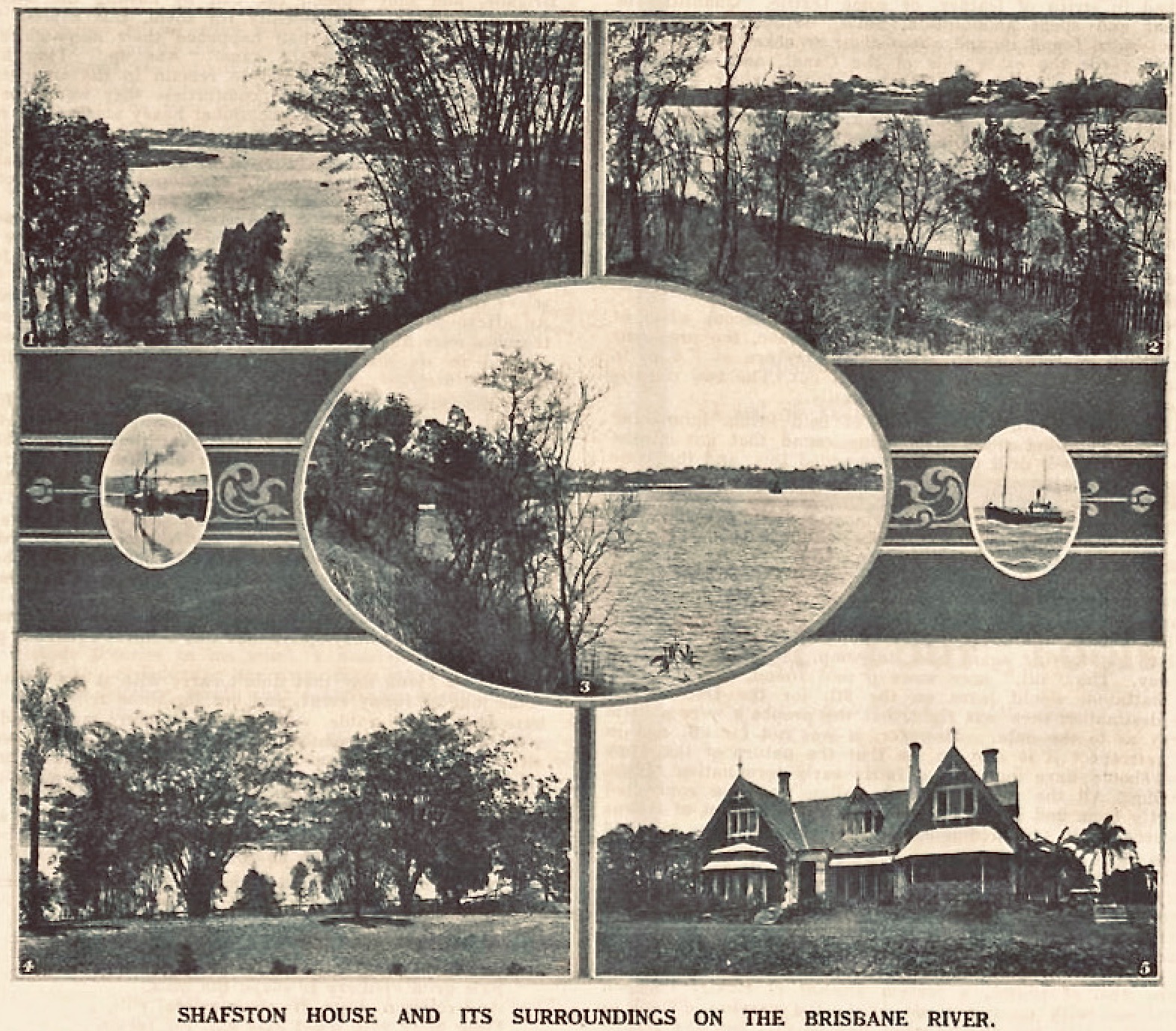
SAY NO to Shafston House Development
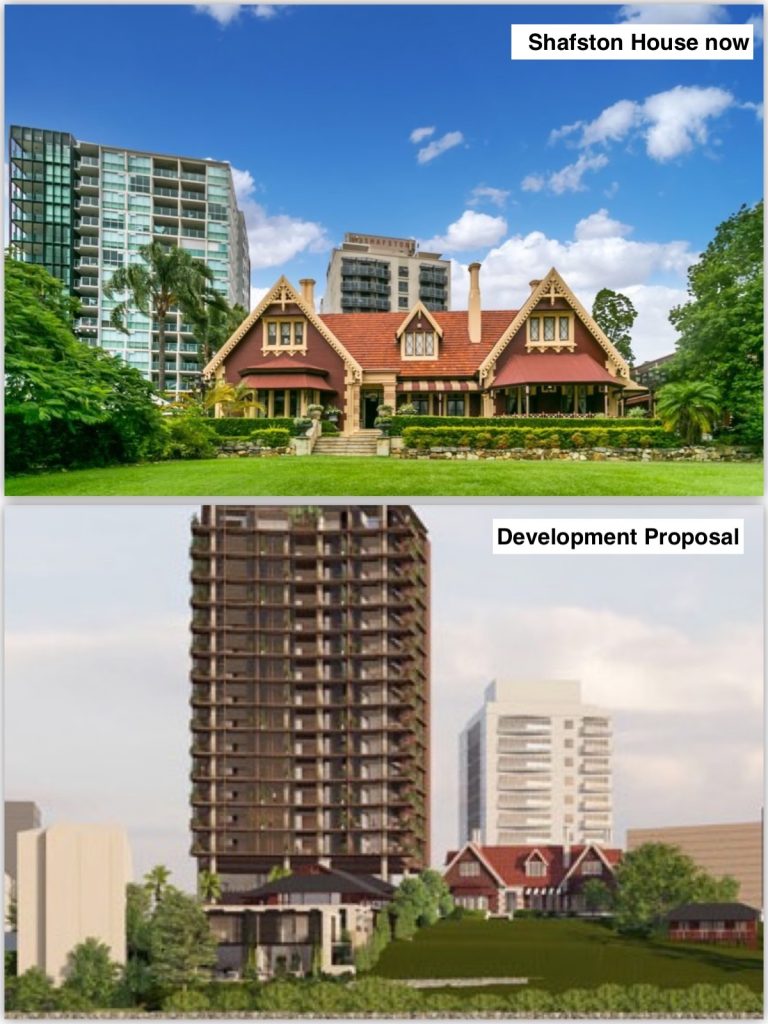 The Shafston House State heritage listing covers the entire site and includes the historic Shafston House (1851-1930s), the former ward buildings (1919), orderlies’ quarters (1928), and the Postal Depot (1937).
The Shafston House State heritage listing covers the entire site and includes the historic Shafston House (1851-1930s), the former ward buildings (1919), orderlies’ quarters (1928), and the Postal Depot (1937).
Now a developer wants to permanently destroy this unique landmark property which has been treasured and admired by locals and visitors alike and which is an important part of colonial history. Shafston House (1851) and Newstead House (1846) are the only remaining colonial riverine estates which still keep their direct connection to the river.
An application to build a 15 storey tower right next to the iconic State Heritage listed Shafston House has been submitted by Burgundy Group on behalf of owner Kevin Pan.
Here’s an overview of the application:
– a 15-storey apartment block right next to Shafston House
– Shafston House to be turned into multiple apartments
– ward buildings to be converted into residential units
– two river homes to be built on lower part of land
– inappropriate deep planting of trees and landscaping
The proposed tower would dwarf the beautiful historic house and dominate the site. The river units would further block the views to and from the house and the river. The overall view from the river and across from New Farm would be spoilt forever.
What can we do?
As the application is code assessable it is not subject to public notification or appeal.However, BCC welcomes comments on the application
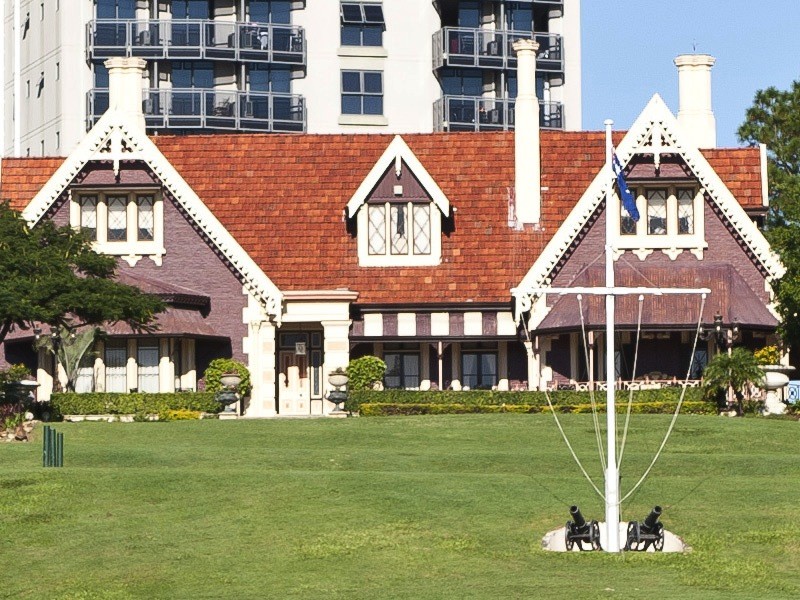
The Newstead House -Shafston House Connection
 The Shafston House State heritage listing covers the entire site and includes the historic Shafston House (1851-1930s), the former ward buildings (1919), orderlies’ quarters (1928), and the Postal Depot (1937).
The Shafston House State heritage listing covers the entire site and includes the historic Shafston House (1851-1930s), the former ward buildings (1919), orderlies’ quarters (1928), and the Postal Depot (1937).
Now a developer wants to permanently destroy this unique landmark property which has been treasured and admired by locals and visitors alike and which is an important part of colonial history. Shafston House (1851) and Newstead House (1846) are the only remaining colonial riverine estates which still keep their direct connection to the river.
An application to build a 15 storey tower right next to the iconic State Heritage listed Shafston House has been submitted by Burgundy Group on behalf of owner Kevin Pan.
Here’s an overview of the application:
– a 15-storey apartment block right next to Shafston House
– Shafston House to be turned into multiple apartments
– ward buildings to be converted into residential units
– two river homes to be built on lower part of land
– inappropriate deep planting of trees and landscaping
The proposed tower would dwarf the beautiful historic house and dominate the site. The river units would further block the views to and from the house and the river. The overall view from the river and across from New Farm would be spoilt forever.
What can we do?
As the application is code assessable it is not subject to public notification or appeal.However, BCC welcomes comments on the application.
Log on to https://developmenti.brisbane.qld.gov.au/
enter the application number: A005933994 and follow the prompts to make a comment. You can attach documents when making a submission.
Preserve the heritage of Shafston House Estate: Anzac HOSTEL 1918-1969
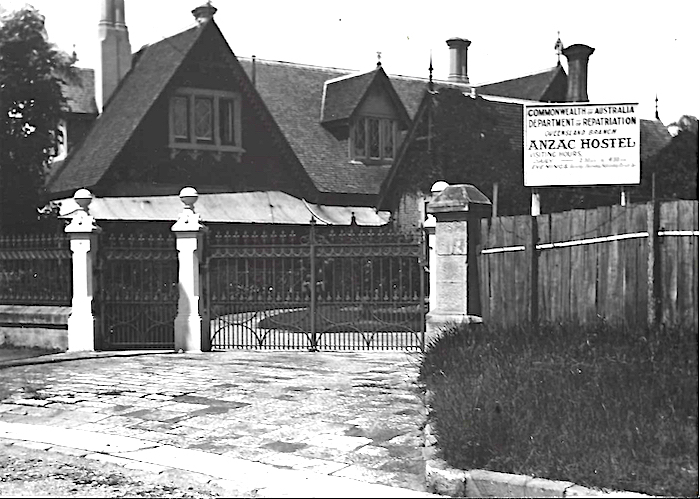
The State heritage-listed Shafston Estate as well as being an iconic landmark riverine property dating back to 1851 and home to some of Brisbane’s early prominent personalities, is also significant for the important role it played for over 50 years as an Anzac Hostel.
Acquired by the Commonwealth Government in 1919 it was the only Anzac Hostel in Queensland developed as a long-term hostel for totally and permanently incapacitated servicemen returning from the Great War. The first patients arrived on 19 July 1920 and Anzac Hostel continued to function as a repatriation hospital until 1969. It is one of only two remaining former WWI repatriation hospitals in Queensland, the other is Rosemount at Windsor.

The Government paid £6,700 for the property and then spent about £4,730 on alterations and additions to bring it up to the required standard in line with other Anzac Hostels in the country. The Red Cross supplied furniture and looked after the beautification of the grounds. At the time the property consisted of the two-storey brick building and a kitchen block set on 4 acres of land facing the river. Apart from the house there were stables, fowl runs and a fernery.
With internal alterations the house initially served as both a hostel and administration centre. The former drawing room was converted into a ward and the bedrooms became rooms for nursing staff. A recreation room was created by removing a wall between rooms at the western end of the house. The upstairs open space attic level was partitioned into new bedrooms for nurses and a store room; the landing became a common room. The kitchen courtyard was roofed over and two new rooms built there. A new timber laundry block was built at the southern end of the kitchen and the stables were converted into quarters for orderlies.
A major addition was a new open-sided ward block built on the terraced front grounds to the north-east of the main house. The single-storeyed block was high-set on stumps and connected to the house by a covered way, with an ablutions block attached on the eastern side.

The ward block with its open verandahs to catch the breezes and maximise air flow was characteristic of the public health theory at the time, which recognised the benefits of fresh air in the recuperative process and maintaining good health generally.
In the late 1920s and 1930s the Commonwealth subdivided and sold the southern part of the property, reducing the house grounds to just over 2 acres (0.8 hectare). The early brick stables building was demolished and replaced in 1928 by a small timber building to the northwest of the house to become quarters for orderlies working at the hostel. It had three rooms and a verandah with toilets at the back. The 1919 laundry block was moved to a position just east of the kitchen block and a new garage was built in the southwest corner of the remaining grounds, near Thorn Street.
The entire Shafston House Estate was listed on the State Heritage Register on 7 February 2005 and includes all buildings associated with its time as an Anzac Hostel as well as the grounds leading down to the river. It is an important and irreplaceable part of the heritage of Brisbane and Queensland and must be preserved in trust for the use of present and future generations.
(Qld Heritage Register/ Repatriation Journal , 16 February 1920/Trove/Hutchies’ 100th book)
next: Royal visit to Anzac Hostel
